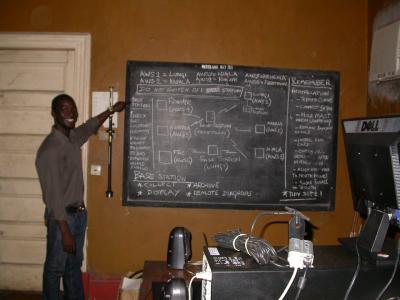
National Adaptation Programmes of Action (NAPAs) provide a process for Least Developed Countries (LDCs) to identify priority activities that respond to their immediate needs to adapt to climate change, ultimately leading to the implementation of projects aimed at reducing the economic and social costs of climate change.
Key Vulnerabilities:
- Agriculture/Food Security
- Coastal Zones and Marine Ecosystems
- Water Resources
- Public Health
- Fisheries
- National
- Country Office
- National Governments
Through improved capacity building and project identification, government agencies and other actors will increase their abilities to insulate at risk urban and rural populations from the adverse effects of climate change.
- Ministry of Energy and Water Resource, Government of Sierra Leone
- Ministry of Fisheries and Marine Resources, Government of Sierra Leone
- United Nations Development Programme (UNDP)
- Global Environment Facility (GEF)
- Ministry of Lands, Country Planning and Environment;Government of Sierra Leone
- Sierra Leone Environment Protection Agency
- Sierra Leone Meteorological Department
The government of Sierra Leone has adopted short-term development plans based on the Millennium Development Goals (MDGs), the Poverty Reduction Strategy Paper (PRSP), the vision 2025 Sierra Leone document and a series of action plans which are project (short-term) driven. These development (sectoral) plans constitute baseline development strategies which have not taken onboard stresses that can be created by climate change. The NAPA projects seeks to address climate change related stresses or shocks that will disrupt the process of development. This report also contains priority activities and projects which are to be undertaken to enable Sierra Leone meet its immediate needs and respond to her most urgent concerns with regards to adaptation to the adverse effects of climate change.
Sierra Leone has developed many adaptation projects to address adverse effects of climate change based on existing coping mechanisms and practices such as Develop and enact appropriate policies and regulations relevant to the development of coastal communities, urban growth planning, and critical coastal ecosystems preservation and the Establishment of a National Sea-Level Observing System for Sierra Leone.
Climate Change is known to have adversely affected the environment, agriculture, food security, and the lives and livelihood of large communities. Fishermen are known to have lost their lives in storms and passenger boats have encountered weather-related accidents, even though some go unreported. Flooding is known to have affected agriculture and habitats of people in Sierra Leone and their suffering has been aggravated by the attending health problems of water-borne diseases (typhoid dysentery cholera and diarrhea) due to lack of safe drinking water.
Key Vulnerabilities:
- Agriculture/Food Security
- Coastal Zones and Marine Ecosystems
- Water Resources
- Public Health
- Fisheries
- Land Resources
- Terrestrial Ecosystems
- Soils
- Biodiversity
- Energy
Climate Related Hazards:
- Floods
- Dry spells
- Thunderstorms
- Shifting rainfall patterns
- Landslides
Potential Adaptation Measures:
Agriculture and Food Security
- Educational & outreach activities to change management practices to those suited to climate change
- Switch to different cultivars
- Improve and conserve soils
- Enhance irrigation efficiency and/or expand irrigation
- Establish seed banks
Water Resources
- Develop and introduce flood and drought monitoring and control system
- Improve or develop water management
- Alter system operating rules, e.g. pricing policies, legislation
Coastal Zones and Marine Ecosystems
- Develop Integrated Coastal Zone Management
- Develop planning/new investment requirements
- Protect, including building sea walls, and beach nourishment
- Retreat
- Research/monitor the coastal ecosystem
Priority Adaptation Projects
Agriculture Sector
- Develop irrigation and land drainage system for agriculture
- Develop and implement agricultural land-use and land cover management
- Promote swamp land farming
Forestry Sector
- Promote the use of renewable energy (solar energy) and improve energy efficiency and conservation by retrofitting existing and future structures
- Establish forest reserves, protected Areas and National Park/Sanctuaries and redemarcate existing ones in order to maintain their integrity
- Management and protection of forests reserves and catchments areas including wetlands and reduce dependence on firewood and charcoal by using liquid fuel (LPG) and bio fuels (ethanol/methane/oils)
Water/Hydrology Sector
- Improve water research, monitoring and management
- Improvement of the efficiency of existing water supply systems in both urban rural areas
- Promote rain water harvesting and develop an integrated management system for fresh water bodies
Coastal Zone Development
- Develop an Integrated Coastal Zone Management Plan
- Rehabilitate degraded coastal habitats
- Develop and enact appropriate policies and regulations relevant to the development of coastal communities, urban growth planning, and wetland preservation
Fisheries Sector
- Promote sustainable fishing practices and develop aquaculture
- Improve weather forecasting and develop marine meteorological services
- Preserve and restore essential habitats; promote conservation and environmental education
Health Sector
- Increase the use of insecticide treated materials (ITMs) as a key strategy in malaria control
- Support HIV/AIDs prevention activities
- Develop appropriate sanitation programs
Meteorology Sector
- Establishment on National Early Warning System
- Improve research and weather forecasting capabilities and rehabilitate national weather stations as well as educate meteorological department personnel to forecast and inform about particular dangerous or extreme events
- Raise public awareness and mainstream gender perspectives into climate change issues
- Foster cooperation with International Conventions and Programmes
- UNDPJessica TroniRegional Technical Advisor
